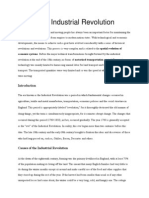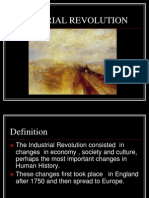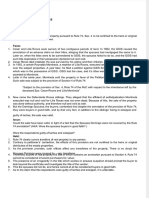0 ratings0% found this document useful (0 votes)
56 viewsThe Industrial Revolution
The Industrial Revolution
Uploaded by
Michael SorkinThe Industrial Revolution began in Europe in the late 18th century, driven by population growth, economic expansion, and technological innovations. England was the first to industrialize due to existing capital, free trade policies, a large labor supply from displaced peasants, and a political system supportive of merchants. The cotton industry was the take-off sector, revolutionized by inventions like the spinning jenny and steam engine that vastly increased production. Agricultural changes like enclosure acts consolidated small farms, driving peasants to cities to work in the new factories.
Copyright:
© All Rights Reserved
Available Formats
Download as DOCX, PDF, TXT or read online from Scribd
The Industrial Revolution
The Industrial Revolution
Uploaded by
Michael Sorkin0 ratings0% found this document useful (0 votes)
56 views4 pagesThe Industrial Revolution began in Europe in the late 18th century, driven by population growth, economic expansion, and technological innovations. England was the first to industrialize due to existing capital, free trade policies, a large labor supply from displaced peasants, and a political system supportive of merchants. The cotton industry was the take-off sector, revolutionized by inventions like the spinning jenny and steam engine that vastly increased production. Agricultural changes like enclosure acts consolidated small farms, driving peasants to cities to work in the new factories.
Original Description:
The Industrial Revolution
Copyright
© © All Rights Reserved
Available Formats
DOCX, PDF, TXT or read online from Scribd
Share this document
Did you find this document useful?
Is this content inappropriate?
The Industrial Revolution began in Europe in the late 18th century, driven by population growth, economic expansion, and technological innovations. England was the first to industrialize due to existing capital, free trade policies, a large labor supply from displaced peasants, and a political system supportive of merchants. The cotton industry was the take-off sector, revolutionized by inventions like the spinning jenny and steam engine that vastly increased production. Agricultural changes like enclosure acts consolidated small farms, driving peasants to cities to work in the new factories.
Copyright:
© All Rights Reserved
Available Formats
Download as DOCX, PDF, TXT or read online from Scribd
Download as docx, pdf, or txt
0 ratings0% found this document useful (0 votes)
56 views4 pagesThe Industrial Revolution
The Industrial Revolution
Uploaded by
Michael SorkinThe Industrial Revolution began in Europe in the late 18th century, driven by population growth, economic expansion, and technological innovations. England was the first to industrialize due to existing capital, free trade policies, a large labor supply from displaced peasants, and a political system supportive of merchants. The cotton industry was the take-off sector, revolutionized by inventions like the spinning jenny and steam engine that vastly increased production. Agricultural changes like enclosure acts consolidated small farms, driving peasants to cities to work in the new factories.
Copyright:
© All Rights Reserved
Available Formats
Download as DOCX, PDF, TXT or read online from Scribd
Download as docx, pdf, or txt
You are on page 1of 4
The Industrial Revolution
I. Demographic Change
Prior to the eighteenth century, the levels of populations seemed to flow in
cyclical, or wave-like patterns, depending on natural phenomena such as
crop failures, plagues, etc.
Around 1730, a new era in Europe’s demography began. During the 18th
century;
-Europe’s population skyrocketed, jumping from 120 to 190 million. Prussia,
Sweden, Spain, France, and especially England experienced tremendous
population increases during this period.
-After this time, the cyclic behavior of the populations stopped, and Europe’s
population simply continued to increase.
The rapid population growth was, according to historians, caused by a
decline in mortality rates in all the countries except for England. The decline
in mortality rates occurred b/c Europe began to enjoy a more stable and
better food supply
Disease was still a major problem, but, on the whole, mortality rates declined.
II. Economic Growth
During the 18th century, overall wealth also increased, although the growth
was not consistent. Still, the overall trend was a positive one.
Significant growth began around 1730 and continued until 1815. This period
was characterized by gradual price inflation
- The growth, however, did not affect all sectors of society in the same way. Though
the gradual increase in prices was good for landlords, employers, merchants, and
landed peasants, it was very bad for the poor, landless peasants, who could barely
afford to live.
Protoindustrialization led to increased manufacturing and population growth
in rural areas. Additionally, it strengthened marketing networks, helped
merchants get more $
III. Changes in Industry
Though, during the 18th century, most industries remained the same,
dramatic change was beginning to occur, especially in the manufacturing of
cotton cloth. The changes in industry were meant to increase the
productivity of labor through new technologies.
Increases in performance: before Europeans could change the format of
industry, they had to face major obstacles and make changes that affected the
very structure of European society.
-Europeans faced many difficulties as they attempted to change the structure of
the economy, such as:
-Small Market Size: since European countries were cut off from one another for
both physical and political reasons, merchants were forced to deal with very limited
markets. This slowed the growth of specialized manufacturing and limited the
mobility of capital and labor.
-Skewed Distribution of Wealth → since the aristocracy used most of the income,
merchants would cater to their desires and make small quantities of luxury goods,
as opposed to lots of cheap goods that would be accessible to the public. This
screwed up supply and demand.
-Property Rights/Privileges → these traditional institutions worked against
innovation, as rents and tolls often sucked up capital that would otherwise be
available to both would-be consumers (peasants) and the entrepreneurs
(merchants).
-Guild/Government Regulations → were huge problems for the merchants. As
the guild regulations established a standard, traditional procedure for industry,
which was not be changed, they made innovation exceedingly difficult. Government
restrictions on economic activity and licensing of monopolies only made it more
difficult for merchants.
-Cultural Attitudes → as many Europeans, especially the nobles, still regarded $
as dirty and simply wanted to have their titles, going into business was discouraged.
III. Laissez-Faire Economics
Many Europeans began to question and criticize the barriers that prevented
further industrialization and innovation. They called for less control of the
economy.
Adam Smith: a Scottish philosopher who epitomized the concerns and
desires of the age, and wrote An Inquiry into the Nature and Causes of the
Wealth of Nations
-Smith believed that $ was not actually wealth, but only showed it, and that
real wealth consisted of the added value of manufactured items produced by
invested capital. Most importantly, however, he stated that economic
progress required that each individual be allowed to pursue his/her self-
interest freely w/out restrictions for this would lead to economic growth.
- Smith also introduced the concept of the invisible hand that stated that if all
individuals follow their own self-interest, it would be for the economic good
of everyone, since everyone will do what they do best.
Laissez-faire economics really caught on, especially in England, and in 1786
France and Britain signed a free-trade treaty. Guilds were growing weaker,
and in 1791, the French got rid of them. In the 1790s, the English also began
to pass laws against them, and the merchants gained freedom.
IV. England Begins to Industrialize
England was the first nation to develop a social structure supportive of
innovation and economic growth. So, why was it England? This is b/c of
many advantages, such as:
-Geography: England was close to the sea, which allowed trade w/foreign nations
and colonies. Also, England had two great resources essential to industry, iron and
coal, as well as a lot of good, productive farmlands.
-Existing Capital to Invest → the English began with a store of capital from the
colonies, which led to the creation of a banking and investing system – the Bank of
England – in 1694. The bank took responsibility of England’s public dept, sold
shares to the public, and met the interest payments for shareholders. This helped
stabilize the markets.
-Free Trade → the English had markets in their colonies, the other European powers
(free trade agreement w/ France in 1786) and the Spanish colonies b/c of the
Treaty of Utrecht.
-Labor Supply → slavery, cheap labor (peasants) due to the Enclosure Acts, which
drove the peasants out of the communal farmlands and made them look for work.
-Friendly Political Environment → since the gentry were in control of the
government (since they had Parliament) they could pass laws favorable to the
merchants.
-Navy
V. Cotton Begins Industrialization
Since England had developed a social structure supportive of
industrialization, all it needed was a take off industry, or an industry that
would begin a pattern of industrialization all the others would follow. In
England’s case, this industry was cotton manufacturing.
Due to the slave labor in the plantations, there was a very large supply of raw
cotton. There was also a very high demand for the durable, cheap cotton
goods. However, the putting-out system had reached its limits in
productions, so merchants were ready to take the next step towards
industrialization.
Richard Arkwright: inventor of the water frame, which was able to twist
fibers into thread using waterpower.
James Watt: inventor of the steam engine. Arkwright asked Watt to use steam
engines to drive his spinning machines, and the first factories were created.
Edmund Cartwright: inventor of a power-driven loom.
-Though the opposition of handloom weavers and technical flaws made the
loom not really become available until the 19th century, once it became
available, both spinning and weaving could go incredibly fast.
The cotton industry was revolutionized by the 19th century, for goods could
be made incredibly fast, and merchants could house all their workers in
factories and watch them work.
-After industrialization, the price of cotton fell tremendously, and it became
available to many poorer people.
VI. Changes in Agriculture
In England, many peasants were able to leave the country and go to the city,
where they found work as factory laborers, because of the new agricultural
techniques, which caused an increase in efficiency and productivity.
If it hadn’t been for these changes, the peasants could not have left.
Convertible Husbandry: instead of letting land lie unused every second or
third year
Charles Townshend: innovator who proved the value of planting turnips
instead of resting land.
Jethro Tull: noble who was into agricultural innovation.
-In addition to convertible husbandry, innovators experimented with selective
breeding of animals.
Enclosure Movement: throughout Europe, all towns shared communal lands,
which were divided into small plots. This made it very difficult to change
agricultural techniques, since the village as a whole had to agree to a certain
technique.
But, in England, Parliament was able enclose all the land in a village, even
against the will of the village itself. In the end, the communal field system
was practically eradicated in England, leading to the domination of rural
society by great landlords and their tenant farmers. Enclosure also forced
many peasants to leave for the cities, where they could then find work.
. Since, throughout the continent, peasants were barely surviving, they had
little time to worry about efficiency; change came very slowly, especially in
Eastern Europe.
You might also like
- Mulgrew MillerDocument14 pagesMulgrew MillerHans-Christian Hasse100% (2)
- The Industrial RevolutionDocument8 pagesThe Industrial RevolutionRamita Udayashankar83% (6)
- Chapter 18 The Wealth of NationsDocument22 pagesChapter 18 The Wealth of NationsJonathan Daniel KeckNo ratings yet
- The Industrial Revolution PDFDocument3 pagesThe Industrial Revolution PDFjazongNo ratings yet
- Cultural Perspectives Romantic Love: Personal Relationships, 3Document13 pagesCultural Perspectives Romantic Love: Personal Relationships, 3MPNo ratings yet
- Industrial RevolutionDocument9 pagesIndustrial RevolutionAbhinav Ashok ChandelNo ratings yet
- Introduction 1Document12 pagesIntroduction 1sunil khandelwalNo ratings yet
- Industrial Revolution Historical Context in 1789 - Romanticism Words WorthDocument4 pagesIndustrial Revolution Historical Context in 1789 - Romanticism Words WorthCesare MancinelliNo ratings yet
- The Industrial Revolution and The Birth of CapitalismDocument25 pagesThe Industrial Revolution and The Birth of Capitalismnusaibahhasan222No ratings yet
- Question: Why Did Industrial Revolution Occur in England?Document7 pagesQuestion: Why Did Industrial Revolution Occur in England?Lê NguyễnNo ratings yet
- La Revoloucion IndustrialDocument5 pagesLa Revoloucion IndustrialESTELA ORÚS FALGÁSNo ratings yet
- CH 19 EssaysDocument5 pagesCH 19 EssaysJessica CottaNo ratings yet
- AP Euro Notes - RevolutionsDocument23 pagesAP Euro Notes - RevolutionsjoeyNo ratings yet
- Unit I-EHDocument32 pagesUnit I-EHFaraz SiddiquiNo ratings yet
- La Revoloucion IndustrialDocument5 pagesLa Revoloucion IndustrialESTELA ORÚS FALGÁSNo ratings yet
- Lesson 6Document20 pagesLesson 6hy5pjpssswNo ratings yet
- Industrialization and NationalismDocument17 pagesIndustrialization and NationalismCarl Edward TicalaNo ratings yet
- Mid Term Examination HistoryDocument7 pagesMid Term Examination HistoryUtkarsh SinghNo ratings yet
- The Industrial Revolution 3 EsoDocument15 pagesThe Industrial Revolution 3 EsoAitana RlNo ratings yet
- Industrial RevolutionDocument6 pagesIndustrial Revolutionbench SantosNo ratings yet
- Activitats Revolució IndustrialDocument5 pagesActivitats Revolució IndustrialYaniraaa akasjsjiNo ratings yet
- The Industrial Revolution in EUROPEDocument3 pagesThe Industrial Revolution in EUROPEweidforeverNo ratings yet
- Apuntes HistoriaDocument19 pagesApuntes Historiaamparooo20No ratings yet
- World History 2 (Lorejoy Dagale BSED IIIB)Document43 pagesWorld History 2 (Lorejoy Dagale BSED IIIB)Lorejoy DagaleNo ratings yet
- U.2Economic HistoryDocument4 pagesU.2Economic HistoryJoseNo ratings yet
- Industrial Revolution OutlineDocument8 pagesIndustrial Revolution OutlineGeraldine GuarinNo ratings yet
- Economic History - 1 February 13th, 2020Document54 pagesEconomic History - 1 February 13th, 2020GediminasNo ratings yet
- The Industrial RevolutionDocument9 pagesThe Industrial RevolutionChetanya MundachaliNo ratings yet
- Mckay Irm Ch21Document19 pagesMckay Irm Ch21joshpatel99100% (1)
- Introduction To Chapter: Feudalism CapitalismDocument15 pagesIntroduction To Chapter: Feudalism CapitalismNishant UpadhyayNo ratings yet
- Industrial Revolution 2ndDocument13 pagesIndustrial Revolution 2ndTOP4UNo ratings yet
- Colonial ImperialismDocument5 pagesColonial Imperialismclapmap0814No ratings yet
- Industrial RevolutionDocument14 pagesIndustrial RevolutionAnupam RoyNo ratings yet
- Chapter 1 h4Document8 pagesChapter 1 h4mesfreressontnulNo ratings yet
- What Is Industrialisation?: Agrarian Society Industrial Economy ManufacturingDocument16 pagesWhat Is Industrialisation?: Agrarian Society Industrial Economy ManufacturingSurya YerraNo ratings yet
- Natgeo Industrial Revolution Labor Life 53441 Article - OnlyDocument3 pagesNatgeo Industrial Revolution Labor Life 53441 Article - OnlyAlen PereiraNo ratings yet
- OriginsDocument6 pagesOriginsEnas AbdAllahNo ratings yet
- (Old NCERT World History Ch7) Industrial Revolution, Capitalism, Their Effect On Society, Rise of Trade Unions - Socialism Mrunal PDFDocument12 pages(Old NCERT World History Ch7) Industrial Revolution, Capitalism, Their Effect On Society, Rise of Trade Unions - Socialism Mrunal PDFDevesh Jhariya0% (1)
- Prerequisites For The Industrial RevolutionDocument3 pagesPrerequisites For The Industrial RevolutionSonya BladeNo ratings yet
- Introduction To Chapter: Feudalism CapitalismDocument15 pagesIntroduction To Chapter: Feudalism CapitalismIliasNo ratings yet
- Notes World HistoryDocument87 pagesNotes World HistoryHari ShankarNo ratings yet
- An Age of Revolutions in Europe and The AmericasDocument13 pagesAn Age of Revolutions in Europe and The Americas008164995No ratings yet
- La Revoloucion IndustrialDocument8 pagesLa Revoloucion IndustrialESTELA ORÚS FALGÁSNo ratings yet
- Completo ResumenDocument22 pagesCompleto Resumenamparooo20No ratings yet
- Chapter 22 - Summary and OutlineDocument5 pagesChapter 22 - Summary and Outlinemirbramo50% (2)
- Industrial Revolution: Unit 3 Chapter 9Document15 pagesIndustrial Revolution: Unit 3 Chapter 9api-501798779No ratings yet
- The Political Order After NapoleonDocument10 pagesThe Political Order After NapoleonJoNo ratings yet
- A-Level Industrial Revolution NotesDocument38 pagesA-Level Industrial Revolution NotesNyasha MatimbaNo ratings yet
- The Making of A Global WorldDocument5 pagesThe Making of A Global Worldxejis32065No ratings yet
- Old NCERT World History Ch12Document208 pagesOld NCERT World History Ch12Aarti KumariNo ratings yet
- Industrila RevolutionDocument26 pagesIndustrila RevolutionAjay Pratap SinghNo ratings yet
- Unit-6 Patterns of Industrialisation PDFDocument12 pagesUnit-6 Patterns of Industrialisation PDFNavdeep SinghNo ratings yet
- The Modern Rise of Population: by T. Mckeown. 1976. London: Edward Arnold. A Vol. In-8° 176 PP 1Document6 pagesThe Modern Rise of Population: by T. Mckeown. 1976. London: Edward Arnold. A Vol. In-8° 176 PP 1Renata JesúsNo ratings yet
- Industrial Revolution ClassDocument44 pagesIndustrial Revolution ClassMarius TorrentsNo ratings yet
- The Industrial Revolution: Case StudyDocument15 pagesThe Industrial Revolution: Case StudyAndrés Tallón CastroNo ratings yet
- History Grade 8 Topic 1: The Industrial Revolution in Britain and Southern Africa From 1860Document95 pagesHistory Grade 8 Topic 1: The Industrial Revolution in Britain and Southern Africa From 1860TooniNo ratings yet
- 4 .1 Britain and America: George IIIDocument12 pages4 .1 Britain and America: George IIImicoleNo ratings yet
- 2.0 The Industrial Revolution in 18 Centrury.... 2)Document40 pages2.0 The Industrial Revolution in 18 Centrury.... 2)edwinmasaiNo ratings yet
- 2.0 The Industrial Revolution in 18 Centrury 3Document42 pages2.0 The Industrial Revolution in 18 Centrury 3edwinmasaiNo ratings yet
- The Industrial Revolution: Investigate How Science and Technology Changed the World with 25 ProjectsFrom EverandThe Industrial Revolution: Investigate How Science and Technology Changed the World with 25 ProjectsRating: 4 out of 5 stars4/5 (1)
- The Town Labourer, 1760-1832 (Barnes & Noble Digital Library)From EverandThe Town Labourer, 1760-1832 (Barnes & Noble Digital Library)No ratings yet
- Magi O. HenryDocument10 pagesMagi O. Henrymail2winag100% (2)
- Ting Frost Uhr (2021) Working With Separated FamiliesDocument6 pagesTing Frost Uhr (2021) Working With Separated Families7sunqiiNo ratings yet
- Connective Words WorksheetDocument6 pagesConnective Words WorksheetÉrika AldeaNo ratings yet
- Automobile December 2023Document2 pagesAutomobile December 2023ss1976No ratings yet
- Unfair Labor Practice: FactsDocument35 pagesUnfair Labor Practice: FactsMariam BautistaNo ratings yet
- Configuring Cisco Mobility Express Controller: CLI Setup WizardDocument16 pagesConfiguring Cisco Mobility Express Controller: CLI Setup WizardDidik SudarsonoNo ratings yet
- Bhijit R Fadte: Profile SummaryDocument9 pagesBhijit R Fadte: Profile Summarydevashish raneNo ratings yet
- Sermon PreparationDocument34 pagesSermon PreparationLyshia Marie Enok LibradoNo ratings yet
- QR Code Thesis PDFDocument8 pagesQR Code Thesis PDFWriteMyCollegePaperForMeCanada100% (2)
- Sebenta Inglês AplicadoDocument30 pagesSebenta Inglês AplicadoJoana PimentelNo ratings yet
- Geo Assignment 4Document14 pagesGeo Assignment 4Haneen QamarNo ratings yet
- Geriatric Health NepalDocument51 pagesGeriatric Health Nepalsantoshipoudel08No ratings yet
- 10 Conspiracy Theories That Came TrueDocument5 pages10 Conspiracy Theories That Came TrueJuandelaCruz100% (1)
- Debriefing Final AssignmentDocument19 pagesDebriefing Final AssignmentSmaran GowdaNo ratings yet
- Spouses Domingo V. Roces G.R. No.147468 April 9, 2003 Doc RineDocument2 pagesSpouses Domingo V. Roces G.R. No.147468 April 9, 2003 Doc RineConsuelo Narag GalagalaNo ratings yet
- Unit 3 AssighmentDocument59 pagesUnit 3 Assighmentrumaisaseemab95No ratings yet
- Power of DuaDocument145 pagesPower of Duahilalplaza100% (8)
- B.A. Ll.b. Ix Semester 2018Document4 pagesB.A. Ll.b. Ix Semester 2018ChaudharybanaNo ratings yet
- 36 BUIntl LJ221Document29 pages36 BUIntl LJ221Eswar StarkNo ratings yet
- P e Class Project AssignmentDocument3 pagesP e Class Project Assignmentapi-303146048No ratings yet
- ETZC412 Compre Regular Answer KeysDocument4 pagesETZC412 Compre Regular Answer KeysSrikanth DNo ratings yet
- Error To The District Court of The United States For The Eastern District of Pennsylvania Syllabus HeldDocument4 pagesError To The District Court of The United States For The Eastern District of Pennsylvania Syllabus Heldsabrina gayoNo ratings yet
- HKCareers - CV Templates - 2020Document8 pagesHKCareers - CV Templates - 2020wd edenNo ratings yet
- CSTUPDocument8 pagesCSTUPsaurabh singhNo ratings yet
- Triduum Schedule - ST Joseph 2022Document2 pagesTriduum Schedule - ST Joseph 2022Lee Vergel EstacioNo ratings yet
- 2023-2024 Planner V1.0 - PUBLICDocument1 page2023-2024 Planner V1.0 - PUBLICCavan LopezNo ratings yet
- Singer-Songwriter Jamie Skylar Makes Cosmic Connection With MarmaladeDocument3 pagesSinger-Songwriter Jamie Skylar Makes Cosmic Connection With MarmaladePR.comNo ratings yet
- Based On Most Essential Learning Competencies (MELC) : Republic of The PhilippinesDocument2 pagesBased On Most Essential Learning Competencies (MELC) : Republic of The PhilippinesLeafar Etraton Serodar II100% (2)

























































































